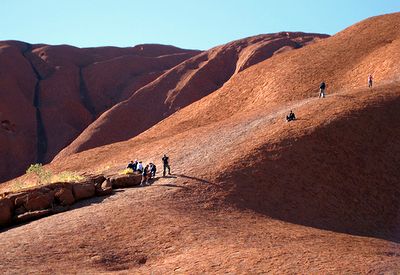Uluru, often referred to as Ayers Rock, stands as a monumental sandstone monolith in the heart of Australia’s arid interior. Its cultural and spiritual significance to the Indigenous Anangu people is profound, representing not just a geological wonder, but a revered symbol of heritage and tradition. Travelers venturing to Uluru can expect an eclectic array of experiences that range from breathtaking natural sights to deeply immersive cultural encounters. Within this article, we shall traverse the many facets of Uluru, elucidating what makes it a quintessential element of Australia’s Outback.
One of the most alluring features of Uluru is its breathtaking physicality. Towering at 348 meters above sea level, the rock itself challenges the horizon, inviting curious gazes from miles away. The striking color palette of Uluru shifts dramatically with the sunlight, exhibiting vibrant reds, oranges, and even purples at sunrise and sunset. This phenomenon is a result of the iron-oxide present within the rock, which, through oxidation, creates an interplay of shades that is truly mesmerizing. Visitors frequently flock to designated viewing points, such as the Talinguru Nyakunytjaku, to catch the ethereal vistas that epitomize the Australian desert landscape. These moments compel awe and introspection, forging a connection to the Earth that transcends time.
The wildlife surrounding Uluru is equally captivating. The arid landscapes host a myriad of unique flora and fauna, adapted to thrive in this harsh environment. It’s not uncommon to encounter kangaroos, wallabies, and a stunning array of birdlife, including emus and various species of parrots. For the eco-conscious traveler, engaging with this biodiversity presents an opportunity for education and appreciation. Guided tours led by local Indigenous guides offer insights into traditional ecological knowledge, showcasing how the Anangu people have coexisted with the land for thousands of years, adhering to sustainable practices that bolster both environmental and cultural conservation.
Cultural immersion is a fundamental aspect of any visit to Uluru. The Anangu people, custodians of this sacred site, provide a wealth of knowledge regarding their traditions, spiritual beliefs, and connection to the land. Visitors can partake in guided walks that emphasize not only the geological aspects of Uluru but also the rich tapestry of stories that define its cultural identity. The “Mala Walk,” for example, invites guests to engage with significant rock art sites while learning about their significance and the Anangu’s ancestral ties to the land. This introspective journey fosters meaningful dialogue surrounding Indigenous rights and the protection of cultural heritage in the contemporary world.
As dusk falls, the experience at Uluru transcends the visual. The night sky transforms into a celestial tapestry, punctuated by a constellation of stars. The region’s minimal light pollution allows for unparalleled stargazing opportunities, where the Milky Way beckons to be observed in all its glory. The Southern Hemisphere’s iconic constellations, including the Southern Cross and the Pointers, dominate the heavens, creating a sense of wonder and connection to the universe at large.
Activities centred around Uluru extend beyond simple sightseeing. Adventure enthusiasts can undertake guided sunset and sunrise camel tours, experiencing the landscape from a unique vantage point. Riding through the serene desert on a camel is both exhilarating and calming, offering an experience that encapsulates a different facet of Outback life. Moreover, bicycle rentals provide a more personal exploration of the area, allowing adventurers to traverse the base of Uluru at their own pace while soaking in the surrounding landscapes.
Environmental consciousness remains pivotal when discussing Uluru. The recent years have seen a significant shift in attitude towards conservation, reflecting a broader recognition of climate change’s impact on natural wonders. The Anangu people, alongside various organizations, advocate for sustainable tourism practices that prioritize the preservation of Uluru and its surrounding ecosystem. Visitors are encouraged to respect guidelines, such as remaining on designated paths and minimizing their environmental footprint. This ethos fosters a collaborative spirit between tourists and the Anangu, promoting stewardship of one of Australia’s most iconic sites.
It is also imperative to recognize the recent policy changes regarding climbing Uluru, highlighting the growing respect for Indigenous culture and beliefs. The Anangu have expressed a long-standing desire for visitors to honor the sacredness of the rock by refraining from climbing it. This decision underscores the evolving nature of tourism in ecologically and culturally sensitive areas. As visitors engage guiltlessly in alternative experiences—such as learning about the area’s ecology or participating in Dreamtime storytelling—they increase awareness of the customs that enrich the Outback experience.
Facilitating a visit to Uluru can often require thoughtful planning. Numerous accommodation options exist, ranging from campgrounds to luxurious hotels, all designed to cater to diverse traveler needs. From the iconic Ayers Rock Resort, which embraces sustainable practices in its operations, to more rustic camping sites that envelop visitors in natural serenity, options abound. It is wise for travelers to make reservations in advance, particularly during peak tourist seasons, to secure their preferred lodging and activities.
In conclusion, Uluru presents a multifaceted experience that transcends mere travel. It invites visitors to engage with its breathtaking landscapes, immerse themselves in Indigenous culture, and nurture a sense of environmental responsibility. The pulsating heart of Australia’s Outback encapsulates not just the allure of adventure, but also the imperative of conservation—making it a compelling destination for all who seek to resonate with the spirit of this captivating land. Embrace the journey, cherish the memories, and contribute to the ongoing legacy of respect for Uluru and its custodians.
